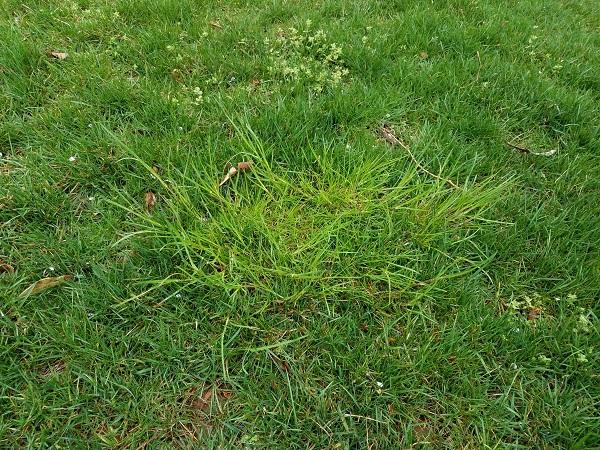Roughstalk bluegrass or rough bluegrass (Poa trivialis) is a common grassy perennial weed in Maryland lawns. It is most noticeable in the springtime. It has a light green color and fine texture that does not blend well with typical tall fescue lawns during the spring and early summer. It grows faster and outcompetes more desirable turf grasses.
Life cycle
Perennial, cool-season grassy weed. Thrives in early spring and fall.
Growth habit
Roughstalk bluegrass is an aggressive, clumping spreader. It forms yellow-green patches in spring and summer and has white trailing tillers (side shoots at the ground level). Grass blades sometimes look shiny on the underside. The stalks can turn red at the base as the plants grow. Seedheads are produced in May-June.
Poa trivialis tends to go dormant during droughts and in the summer, leaving thin areas in the turf before re-growing in the cooler fall season. Also, heavy rainfall followed by hot sunny weather causes this grass to collapse into brown, dead-looking mats. Plants can regenerate from viable buds at the stem bases and may recover by late fall or the following spring.
Reproduction
Roughstalk bluegrass often comes in as a contaminant in grass seed mixes. It spreads by reseeding from established plants and aggressive horizontal stolons.

Photo: David L. Clement, University of Maryland Extension
Conditions that favor growth
It prefers semi-shady conditions in compacted, poorly drained, moist soils (often beginning in drainage swales). Once established, it will spread into sunnier, drier sites.


Photo: David L. Clement, University of Maryland Extension
Management in lawns
Lawn care practices
Maintain healthy, dense turf that can compete and prevent weed establishment.
Unfortunately, the seeds can be found in grass seed mixtures, even in the best blends.
Mechanical management
Small infestations can be dug out; all parts of the root must be removed. Rent a sod cutter to remove large patches. Then reseed with tall fescue or put down sod. This can mask the problem but may not eliminate it if seeds are present in the soil or come from another source.
Manage Weeds Without Chemicals
Chemical treatment in lawns
Perennial grasses growing out of place in lawns are extremely difficult to control selectively in turfgrasses. Roughstalk bluegrass cannot be effectively removed with any herbicides currently on the market. Total lawn renovation or killing the patches using glyphosate (an ingredient in a non-selective herbicide) and then reseeding will slow it down, but because of the vast seed bank in the soil and creeping stolons, it will return.
